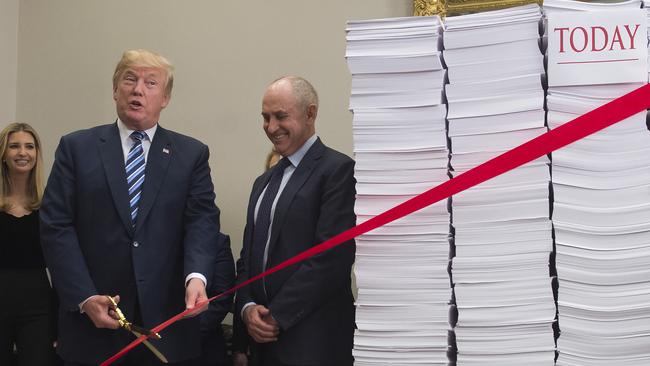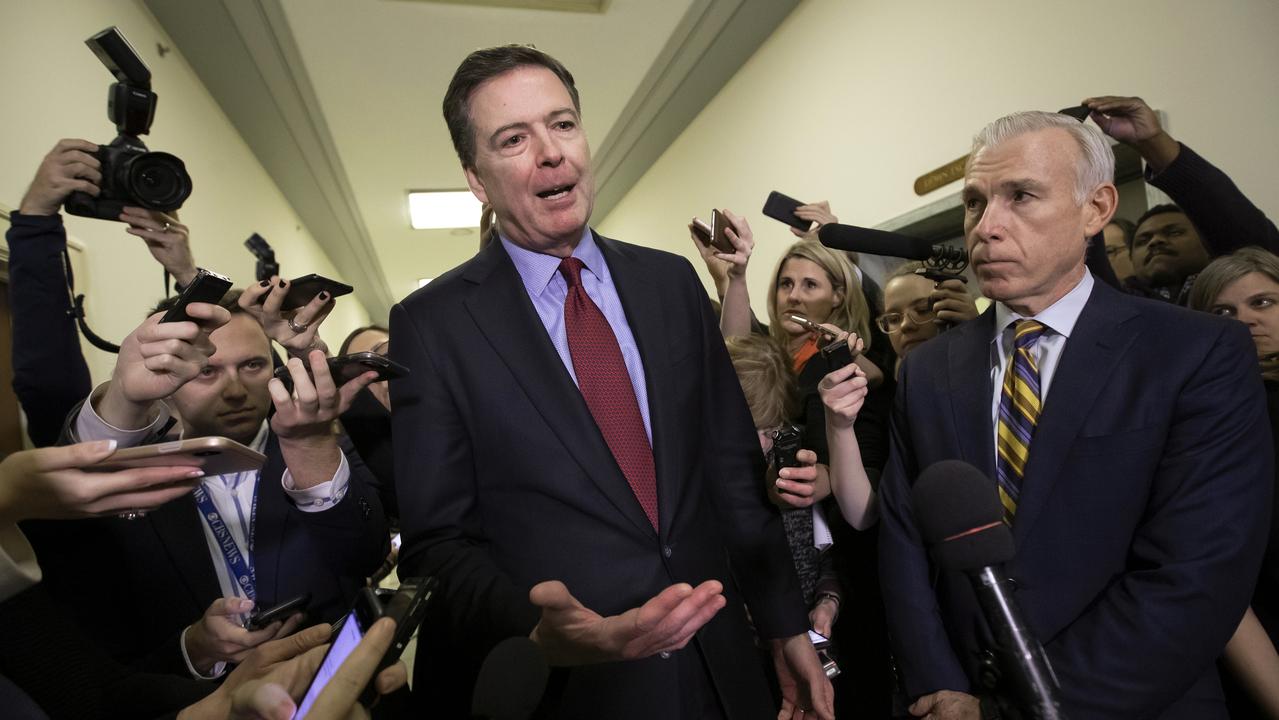Trump’s tax bill: America gambles on economic growth
The tax legislation is a political triumph for Donald Trump, but it remains to be seen how it will affect his legacy.

Donald Trump has made a permanent imprint on the life of all Americans with his sweeping tax reform bill, which will echo across the country and become an integral part of his legacy as President.
The bill is a once-in-a-generation reform based on a simple, bold bet — that a $US1.5 trillion tax cut directed mostly at corporate America will breathe fire into the US economy and repay itself without plunging the country into a debt crisis.
It is a high-stakes gamble that one day may be viewed as mercurial or foolhardy. But it is a unique achievement for Trump, who rightly can tout it as the sort of big-picture reform he promised to deliver if elected.
Trump’s triumph on tax is all the more remarkable because its passage through congress was not blocked by conservative Republicans clamouring for fiscal discipline, as they would once have been in the tea party era.
This was a Republican Party anxious to chalk up a significant win by delivering the most pro-growth tax reform in a generation, and then let the cards fall as they may with future deficits.
The central gamble of this reform package is that by slashing the corporate tax rate from 35 per cent — the highest in the developed world — to only 21 per cent, it will restore the competitiveness of US businesses, unlock a wave of new investment, and create jobs and higher wages for workers, including for Trump’s so-called forgotten people.
The legislation also includes more modest tax cuts for the middle class and a drop in the top personal tax rate from 39.6 per cent to 37 per cent.
At the same time, it shrinks the deduction for state and local taxes, meaning that residents of high-taxing, Democrat-leaning states such as New York and California may end up paying more.
The theory put forward by Trump and the Republicans is that higher economic growth will generate extra tax revenue that will largely pay for the tax cuts rather than push America off a debt cliff.
“This is one of the most important pieces of legislation congress has passed in decades … for all those millions of Americans struggling pay cheque to pay cheque, help is on the way,” House of Representatives Speaker Paul Ryan declared.
“This is a good day for workers … and a great day for growth.”
The plan puts trust — some say too much trust — in corporate America to behave in a certain manner; that is, to use its tax windfall to expand productivity rather than merely rewarding shareholders or hoarding profits. The corporate tax reduction also will put pressure on countries such as Australia to follow suit.
The Trump reform puts its faith in supply-side economics — the notion that lower taxes spur economic growth — to a degree not seen since Ronald Reagan’s sweeping 1986 tax reform, which cut the corporate tax rate from 46 per cent to 34 per cent.
“This is a pretty historical moment for the conservative movement,” Stephen Moore, a supply-sider who is an informal adviser to the President and helped advise candidate Trump on tax during last year’s election campaign, tells Politico magazine.
“I’ve been in this game for 30-some years. This, if it passes, will be the single biggest policy triumph for conservatives since the 1996 welfare reform. It’s up there with the (1981) Reagan tax cuts.”
While Republicans often have been divided on the effectiveness of supply-side economics — George HW Bush famously described it as “voodoo economics” — the father of the conservative tax-cutting movement in the US is often said to be Arthur Laffer.
Laffer was an economics professor when he met Dick Cheney for lunch in 1974. Cheney was an aide to president Gerald Ford at the time.
During the lunch, Laffer scribbled on his napkin the notion that cutting taxes would boost economic growth and that this in turn would create fresh revenue that would pay for the tax cuts.
The theory became known as the Laffer Curve, and the economist’s ideas helped inspire Reagan to announce his first tax cut in 1981, adopting a model that became known as “Reaganomics”.
The effectiveness of this model has been the subject of debate ever since — a debate that has heated up in the light of the Trump tax cuts.

Democrats fiercely oppose the theory, pointing to moments in US history when the opposite appeared true — such as the economic boom during Bill Clinton’s presidency in the 1990s when he raised, rather than cut, taxes.
Trump and the Republicans argue that the $US1.5 trillion tax cut will be repaid through economic growth and therefore will not increase the federal deficit.
It says much about the strength of this belief within Republican ranks today that one of its most fiscally conservative senators, Bob Corker, who originally had opposed the bill because of its impact on the deficit, this week reversed his position.
“This is a bet on our country’s enterprising spirit, and that is a bet I am willing to make,” he said.
The Wall Street Journal reflected this mood in an editorial this week: “After eight years of trying to redistribute income through higher taxes and more subsidies, why not try a return to growth economics?”
US economists are divided on the broader merits supply-side economics, but few mainstream economists believe tax cuts of this size will fully pay for themselves through economic growth alone. This view is supported by several nonpartisan studies including by the congressional joint committee on taxation, which estimated that the reforms would add $US1 trillion to the deficit across 10 years even if the extra projected economic growth was taken into account.
Laffer, now 77 and an economic adviser to Trump, says the committee and others are wrong.
“That’s nonsense. It’s just silly,” he said in a published interview this month.
“When were the best surplus years we’ve ever had? Under (John F.) Kennedy in the go-go 60s with the fastest growth in the US and under Bill Clinton with the fastest growth in the US. When were the two worst years? Nineteen seventy-four — with the slow growth — and the (Barack) Obama-W (George W. Bush) era. There’s nothing that creates surpluses better than economic growth. Period.
“Under Reagan, revenue growth was enormous. From January 1, 1983, to June 30, 1984, that’s 18 months, the total growth during that period of real GDP was 12 per cent. We grew at an 8 per cent annualised rate for a year and a half. That solves lots of problems. Believe me when I tell you.”
If Laffer and the Republicans are wrong about the impact of these tax cuts on the US economy, it means large and politically fraught cuts to government spending will be required to prevent a ballooning deficit.
House Speaker Ryan yesterday conceded that spending cuts to Medicare, Medicaid and welfare programs would be necessary regardless of the tax cuts to help rein in the future federal deficit: “Even if we get the kind of growth we hope to get (from tax cuts), you still have to reform entitlements if you’re going to get this debt under control.
“You cannot grow your way out of the entitlement problem we have coming.”
But Republicans have not tried to launch any serious campaign to cut government programs since 2011. It would be unusually brave for them to try to do so ahead of next November’s mid-term elections, with the party holding vulnerable majorities in the Senate and the house.
Critics argue that now is not the time for a tax cut-driven economic stimulus, when the US economy has recovered from years of anaemic growth and is purring along at a 3 per cent growth rate, with unemployment at a 17-year low of 4.1 per cent.
But few believe the tax cuts will cause the US economy to overheat, and Republicans argue that a phase of robust economic growth is long overdue.
As well as delivering Trump his first major legislative victory, the passage of the tax bill also shows that the Republican Party — which was hopelessly divided over its failed attempts to repeal Obama’s healthcare reform — can unite when it needs to. This will give Trump hope that he can pass his other big-picture initiatives, including those relating to infrastructure and welfare, before next year’s mid-term elections.
But while Trump has succeeded in winning congressional approval for his tax reform plan, he will need to work harder to win public approval.
Polls show that the tax reform package is unpopular, with about 55 per cent of Americans opposing it and only one-third in favour. Only two-thirds of Republican voters approve of the reform package. The President and the Republican Party have tried to win public support by touting the tax reforms as being primarily about a tax cut for middle-class Americans. Yet the size and impact of the tax cuts for middle-class families will be modest as well as temporary, given that, under the bill, the reduction will end in 2025.
According to the congressional tax committee, middle-class families get only 23 per cent of the tax cuts for individuals and by 2027, after the cuts expire, those households would face a net tax increase.
Under the personal tax cut package, the largest tax cuts go to the highest earners.
Households earning between about $US49,000 ($64,000) and $US86,000 will receive an average tax cut of about $US900, or 1.6 per cent of after-tax income. But those with income between about $US308,000 and $US733,000 will see an average tax cut of about $US13,500, or 4.1 per cent of after-tax income.
Democrats are crying foul, saying the tax cuts are heavily skewed towards the rich and companies, rather than towards the middle class and the battlers, including Trump’s forgotten people.
“It’s a disgusting smash-and-grab. It’s an all-out looting of America, a wholesale robbery of the middle class,” Democratic house minority leader Nancy Pelosi said yesterday of the Trump tax bill.
“The GOP tax scam will go down, again, as one of the worst, most scandalous acts of plutocracy in our history.”
So Trump still has some work to do before he can persuade voters that they will be winners from these reforms. It is an important task for him.
A new CNN poll this week shows Trump’s approval rating has fallen to a new low of 35 per cent, down from 45 per cent in March, with 59 per cent of those polled disapproving of the way he is handling his job as President.
But Americans elected Trump on the promise that he would enact sweeping tax reform. The fact he has kept his word by pushing, cajoling and harassing Republicans into passing those laws is no small achievement.
Whatever people may think of Trump, this is a substantial political victory for this President — and his legacy will be shaped heavily by the outcome of the $US1.5 trillion bet he has just placed on the US economy.
Cameron Stewart is also US contributor for Sky News Australia.
-
Key Changes
Highlights of the legislation, which would make about $US1.5 trillion in tax cuts:
Start date: January 1, 2018
Personal income tax rates: The bill retains the current number of brackets, seven, but changes them to 10, 12, 22, 24, 32, 35 and 37 per cent. The top bracket for wealthiest earners, 39.6 under current law, drops to 37 per cent. But it will kick in at a lower level, $US600,000 per married couple, instead of the current $US1 million. The reductions in personal income tax rates are temporary, ending in 2026.
Standard deduction: Used by about 70 per cent of US taxpayers, currently $US6,350 for individuals and $US12,700 for married couples. The bill doubles those levels to $US12,000 for individuals and $US24,000 for couples, expiring in 2026.
Personal exemption: The bill ends the current $US4,050 personal exemption.
State and local taxes: Ends the unlimited federal deduction for state and local income and sales taxes, allowing the deduction only for a total of up to $US10,000 in combined property, income or sales taxes.
Tax credits: Doubles per-child tax credit to $US2,000 for families making up to $US400,000 a year. Up to $US1,400 of the $US2,000 credit is available as a tax refund to lower- and middle-income families with relatively small tax bills. The per- child credit expires in 2026. The bill also provides a tax credit for dependent care for children and older dependents; it retains the current adoption tax credit.
Home mortgage interest deduction: Limits the deduction to interest paid on the first $US750,000 of a new loan for a first or second home. The current limit is $US1 million.
Other deductions: Allows deduction for medical expenses not covered by insurance for 2018 and 2019 when expenses exceed 7.5 per cent of adjusted gross income. That rises to 10 per cent starting in 2020.
Individual insurance mandate: Repeals the requirement in Barack Obama’s health care law that people pay a tax penalty if they don’t purchase health insurance.
Alternative minimum tax: The AMT is aimed at ensuring that higher-earning people and corporations pay at least some tax. For individuals, the bill increases the amount that can be exempted from the AMT. The tax is repealed for corporations.
Inheritance tax: Currently, when someone dies the estate owes taxes on the value of assets transferred to heirs above $US5.5 million for individuals, $US11 million for couples. The bill doubles those limits and repeals the tax in 2025.
Corporate taxes: Bill slashes the current 35 per cent rate to 21 per cent starting January 1.
Pass-through businesses: Millions of US businesses “pass through” their income to individuals, who then pay personal income tax on those earnings, not corporate tax. The bill lets those people deduct 20 per cent of the first $US315,000 of earnings.
Businesses: Bill allows companies to immediately write off the full cost of equipment they buy.
Multinational corporations: Bill ends tax advantages for companies moving overseas.




To join the conversation, please log in. Don't have an account? Register
Join the conversation, you are commenting as Logout